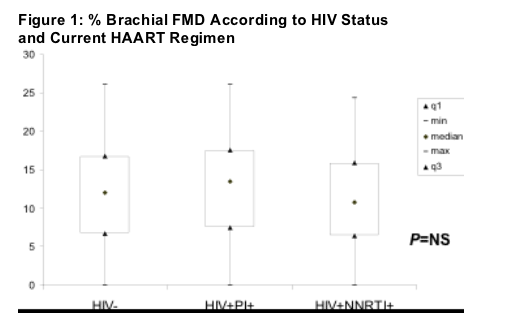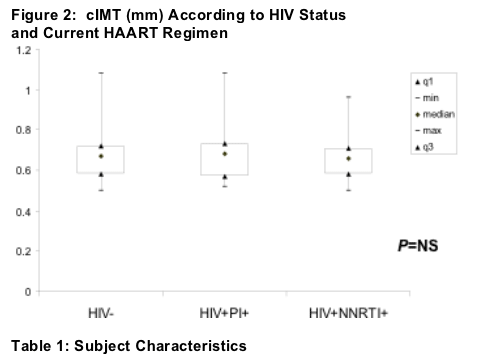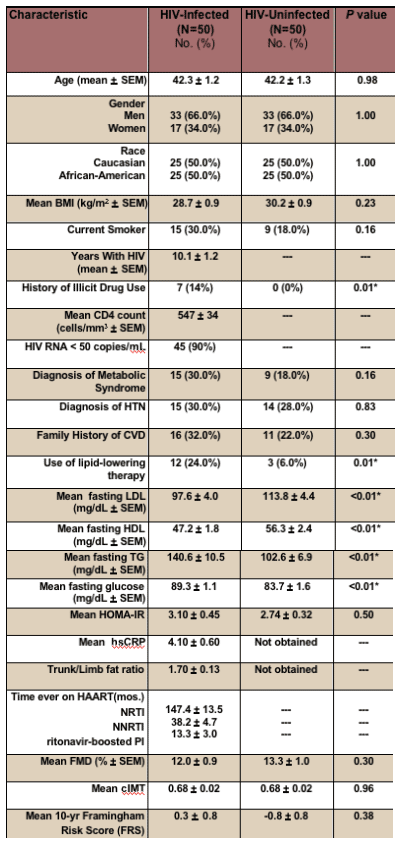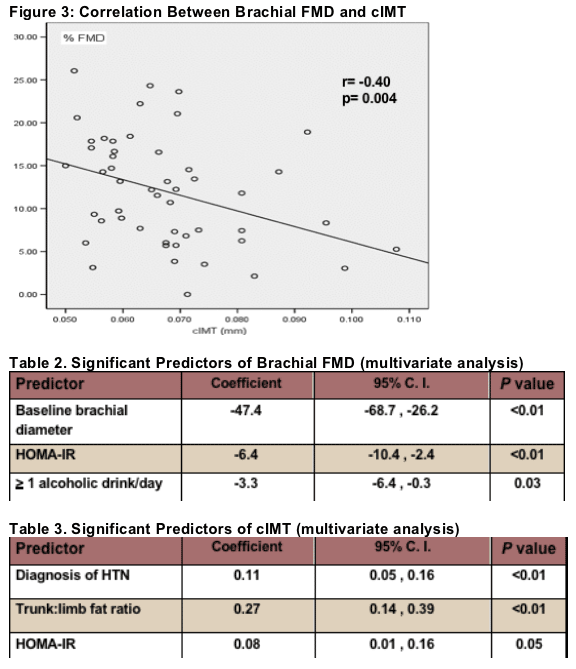 |
 |
 |
| |
Lack of Association between Antiretroviral Therapy and Predictors of Endothelial Function and Cardiovascular Disease (CVD) Risk Among HIV-Infected Persons on Long-Term HAART pioglitazone increased limb fat, exercise reduced limb fat
|
| |
| |
Reported by Jules Levin
9th Intl workshop on Adverse Drug Reactions and Lipodystrophy, July 2007, Sydney, Australia
Kristin Mondy MD, Lisa de las Fuentes MD, Nur Ínen MD, MRCP, Alan Waggoner MHS, RDCS, Corinne Bopp MEd,
Sherry Lasso-Claxton RD, MS, Victor Davila-Roman MD, and Kevin Yarasheski PhD.
Washington University School of Medicine, Saint Louis, MO, USA
AUTHOR CONCLUSIONS
Persons with well-controlled HIV had a CVD risk comparable to matched controls based on brachial FMD, cIMT, and FRS.
Insulin resistance, though not "captured" as part of the Framingham score, was a stronger predictor of brachial FMD and cIMT than lipid parameters, suggesting its importance as a CVD risk factor in the HIV population.
Among HIV-infected, there was a significant correlation between FMD and cIMT, cIMT and FRS, but not FMD and FRS.
Overall, traditional CVD risk factors were more predictive of cIMT than brachial FMD; further longitudinal studies of surrogate CVD markers in HIV are warranted.
ABSTRACT (updated)
Aim:
Controversy exists with regard to CVD risk factors in HIV+ persons. We assessed multiple metabolic and clinical predictors of endothelial function in HIV+ subjects and compared results to HIV-negative controls. Correlation with carotid intima media thickness (cIMT) and Framingham Risk Score (FRS), other well-known surrogates for CVD risk, were also performed.
Methods:
Cross-sectional study of healthy, HIV+ subjects (n=50) on stable HAART. Flow-mediated vasodilation (FMD) of the brachial artery (expressed as % change from baseline diameter), cIMT, oral glucose tolerance test, DEXA, C-reactive protein, and fasting lipids were obtained on all subjects. Multiple linear regression modeling was used to determine significant predictors of FMD and cIMT based on data from univariate models. Results were compared to HIV-negative controls (n=50) matched by age, sex, race, and body mass index (BMI).
Results:
Among HIV+, mean age was 42, 50% African-American, 34% women, 30% hypertensive, 30% smokers, mean BMI 28.7 kg/m2, median CD4 count 521 cells/uL, 42% on a ritonavir-boosted PI. 90% had HIV RNA <50 copies/mL. No subjects were diabetic or currently using illicit drugs. In both univariate and multivariate analyses, predictors of endothelial dysfunction (lower FMD) in HIV+ were higher brachial artery diameter, worsening insulin resistance (HOMA-IR), and > 1 alcoholic drink/day ( adj. r2=0.400, p<0.05). In univariate analysis, predictors of higher cIMT were male gender, older age, hypertension (HTN), family history of premature CVD, higher HOMA-IR, and higher trunk/limb fat ratio (p<0.05 for all). In multivariate analysis, predictors of higher cIMT were HTN, higher trunk/limb fat ratio, and higher HOMA-IR (adj. r2=0.462, p<0.05). There was no association between type or duration of HAART and either FMD or cIMT. Compared to controls, HIV+ subjects had similar mean FMD, cIMT, and FRS (12.0 vs. 13.3% for FMD, 0.68 vs. 0.68 mm for cIMT, 0.3 vs. -0.8 for FRS, p=NS for all). Groups did not differ significantly by HTN, BMI, HOMA-IR, or smoking but HIV+ had lower LDL and HDL cholesterol, and higher triglycerides and glucose compared to controls (p<0.01). Among HIV+ there was significant correlation between FMD and cIMT (r= -0.40, p<0.01 by Spearman's rank), cIMT and FRS (r=0.50, p<0.01), but not FMD and FRS.
Conclusions:
Persons with well-controlled HIV had a CVD risk comparable to matched controls based on FMD, cIMT, and FRS. Despite good correlation between FMD and cIMT, insulin resistance was a stronger predictor of endothelial dysfunction (FMD), whereas traditional CVD risk factors were most predictive of cIMT.
BACKGROUND
Highly active antiretroviral therapy (HAART) has been associated with metabolic complications that may increase patients' risk for cardiovascular disease (CVD).
However, studies using non-invasive surrogate markers such as brachial artery flow-mediated dilation (FMD) and carotid intima media thickness (cIMT) for early CVD have yielded variable results, supporting a multifactorial etiology of CVD among HIV-infected persons.
Further studies are still needed to better determine metabolic and clinical predictors of early CVD in this population.
METHODS
HIV-Infected Patients: Age >18, on stable HAART for at least 6
months, CD4 count >100, no pre-existing vascular disease or diabetes; no active illicit drug use; no opportunistic infection or use of immunomodulating agents in the past 60 days.
HIV-Uninfected Patients: Age >18, non-diabetic, healthy persons with no signs/symptoms of vascular disease and at low risk of HIV.
Data Collection: Patient interview and fasting laboratory data and DEXA were performed at the Washington University General Clinical Research Center and Cardiovascular Clinical Laboratory. For brachial FMD, measurements of brachial artery diameter were made at baseline, immediately after cuff deflation, and at one minute thereafter. For each timepoint, measurements were performed at 5 loci on the two-dimensional images and then averaged. cIMT measures were expressed as the average of multiple images at four sites: the near- and far-wall intima media thickness from both right and left common carotid arteries. All measurements were performed by the same certified vascular sonographer and stored for later off-line analysis.
Statistics: Chi-square or Fisher's exact tests were used for categorical variables and Student's t-test or Mann-Whitney U test for continuous variables. Stepwise linear regression identified independent predictors of increased FMD and cIMT from among factors significant in univariate analyses. HOMA-IR, HIV RNA, trunk:limb fat ratio, and triglycerides were log-transformed for analyses. Spearman's rank test was used for correlations between brachial FMD, cIMT, and FRS. All p values were two-tailed. Analysis was performed using SPSS software.
RESULTS




|
| |
|
 |
 |
|
|